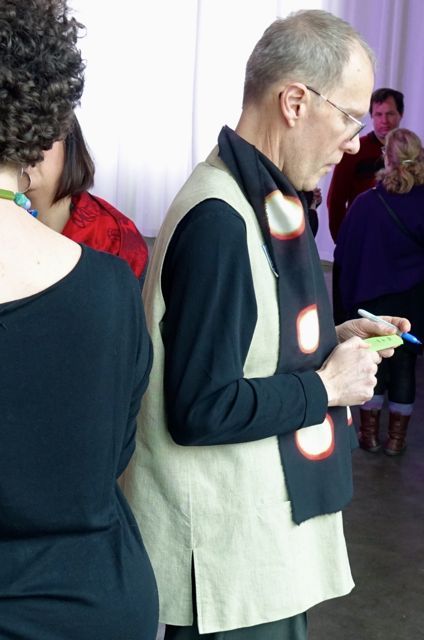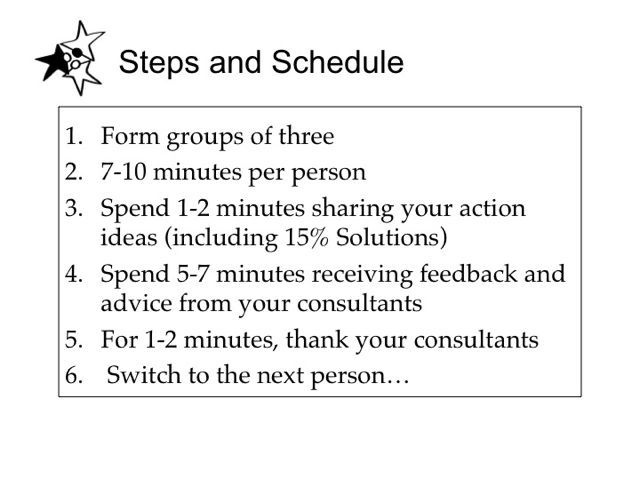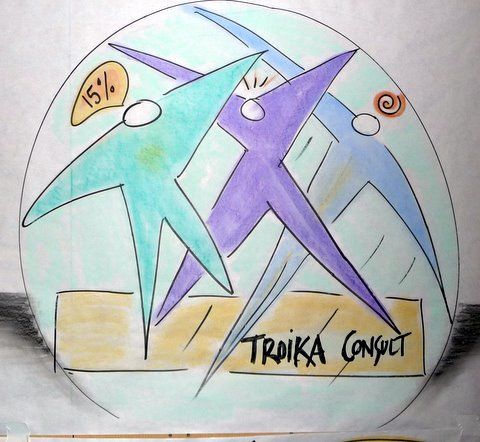![]() Troika Consulting
Troika Consulting
Get Practical and Imaginative Help from Colleagues Immediately (30 min.)
To listen is very hard, because it asks of us so much interior stability that we no longer need to prove ourselves by speeches, arguments, statements or declarations. True listeners no longer have an inner need to make their presence known. They are free to receive, welcome, to accept. – Henri Nouwen
What is made possible? You can help people gain insight on issues they face and unleash local wisdom for addressing them. In quick round-robin “consultations,” individuals ask for help and get advice immediately from two others. Peer-to-peer coaching helps with discovering everyday solutions, revealing patterns, and refining prototypes. This is a simple and effective way to extend coaching support for individuals beyond formal reporting relationships. Troika Consulting is always there for the asking for any individual who wishes to get help from colleagues or friends.
Five Structural Elements – Min Specs
1. Structuring Invitation
- Invite the group to explore the questions “What is your challenge?” and “What kind of help do you need?”
2. How Space Is Arranged and Materials Needed
- Any number of small groups of 3 chairs, knee-to-knee seating preferred. No table!
3. How Participation Is Distributed
- In each round, one participant is the “client,” the others “consultants”
- Everyone has an equal opportunity to receive and give coaching
4. How Groups Are Configured
- Groups of 3
- People with diverse backgrounds and perspectives are most helpful
5. Sequence of Steps and Time Allocation
- Invite participants to reflect on the consulting question (the challenge and the help needed) they plan to ask when they are the clients. 1 min.
- Groups have first client share his or her question. 1-2 min.
- Consultants ask the client clarifying questions. 1-2 min.
- Client turns around with his or her back facing the consultants
- Together, the consultants generate ideas, suggestions, coaching advice. 4-5 min.
- Client turns around and shares what was most valuable about the experience. 1-2 min.
- Groups switch to next person and repeat steps.

WHY? Purposes
- Refine skills in asking for help
- Learn to formulate problems and challenges clearly
- Refine listening and consulting skills
- Develop ability to work across disciplines and functional silos
- Build trust within a group through mutual support
- Build capacity to self-organize
- Create conditions for unimagined solutions to emerge
Tips and Traps
- Invite participants to form groups with mixed roles/functions
- Suggest that participants critique themselves when they fall into traps (e.g., like jumping to conclusions)
- Have the participants try to notice the pattern of support offered. The ideal is to respectfully provoke by telling the client “what you see that you think they do not see”
- Tell participants to take risks while maintaining empathy
- If the first round yields coaching that is not good enough, do a second round
- Beware that two rounds of 10 minutes per client is more effective than one round of 20 minutes per client.
- Keep the spaces safe: if you share anything, do it judiciously
- Questions that spark self-understanding or self-correction may be more powerful than advice about what to do
- Tell clients to try and stay focused on self-reflection by asking, “What is happening here? How am I experiencing what is happening?”
- Make Troika Consulting routine in meetings and conferences
Riffs and Variations
- Meld with 15% Solutions: each client shares a 15% Solution, asking for coaching
- Inviting the client to turn around and sit facing away from his or her consultants once the question has been shared and clarified deepens curiosity, listening, empathy, and risk taking for all. The alternative of not turning around is an option.
- Restrict the coaching to generating only questions to clarify the challenge: no advice giving (aka Q-Storming)
- String together with Helping Heuristics; Heard, Seen, Respected; Nine Whys
Examples
- For the beginning or end of staff meetings
- After a presentation, for giving participants time to formulate and sift next steps
- For students to help one another and to promote peer-to-peer learning
- In the midst of conferences and large-group meetings
- As a self-initiated practice within a group
Attribution: Liberating Structure developed by Henri Lipmanowicz and Keith McCandless.
Collateral Material
Below: Presentation materials for introducing Troika Consulting



